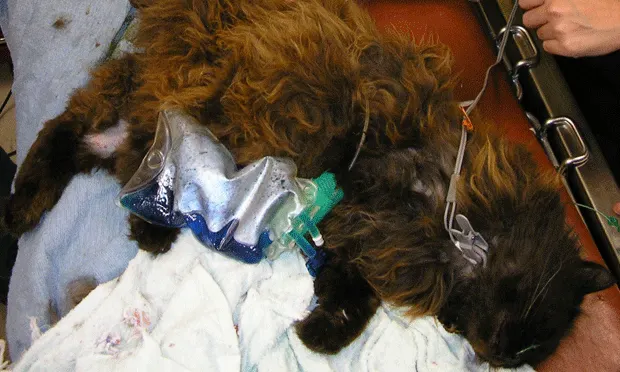Acute Systemic Anaphylaxis in Cats
Annette Litster, BVSc, PhD, FANZCVSc (Feline Med), MMedSci (Clin Epi), Chicago, Illinois

A Persian cat presents with sudden dyspnea and collapse. Upon questioning, the owner reports having begun a course of prescribed antibiotics minutes before the cat collapsed.
An acute systemic reaction can occur on the first exposure to an antigen in cats. The feline lung is the major "shock organ" in such reactions. Severe dyspnea occurs due to lower and/or upper airway edema and is accompanied by acute hypotensive shock, hypoxemia, and occasionally such gastrointestinal signs as vomiting or defecation. Hematocrit may be markedly elevated, probably in association with increased vascular permeability and splenic release of stored red blood cells. Anaphylaxis, which is a severe systemic allergic reaction that can be fatal, requires antigen-specific IgE antibody to be produced in response to previous contact with an antigen. The reaction to an antigen may sometimes occur without prior exposure, and this is called an anaphylactoid reaction.
Anaphylactic reactions have been reported in cats associated with administration of a variety of vaccines and antibiotic preparations. Breakage of heartworms during a surgical extraction procedure in an infected cat may cause an acute (sometimes fatal) shock reaction, which is believed to be acute systemic anaphylaxis.1-4
How to Proceed
The immediate exposure history is important in cats that present with sudden dyspnea and collapse.
Distinguishing acute systemic anaphylaxis from other causes of sudden dyspnea and collapse is usually fairly straightforward because many inciting antigens are iatrogenic and clinical signs usually become apparent within minutes or even seconds.
Currently, no diagnostic tests can confirm that an acute shock reaction is caused by anaphylaxis.
However, the diagnosis is usually made presumptively by using a combination of appropriate history and clinical signs. There may be hemoconcentration (elevated hematocrit) in blood samples collected before treatment begins.
Pathophysiology
After exposure to an allergen, antigen-specific B lymphocytes remain in the circulation. On secondary contact with the specific allergen, these lymphocytes secrete antigen-specific IgE, which binds to specific receptors on mast cells. The antigen-specific IgE crosslinks the receptors, causing a cascade of biochemical processes. Liberation of preformed effector cell granules (degranulation) follows within seconds, releasing such vasoactive substances as histamine, heparin, serotonin, chemotactic factors, and proteases. Histamine-releasing factors and neuropeptides are believed to trigger mast cell degranulation in anaphylactoid reactions. Anaphylactic and anaphylactoid reactions are clinically indistinguishable, as they both result in degranulation of mast cells.
Therapy
Therapy, which is directed at managing the pathophysiologic effects of anaphylaxis, needs to be prompt and aggressive (See Tx At a Glance). Since serotonin is known to be a major mediator in feline mast cells, such antiserotonin drugs as cyproheptadine may be useful in the treatment of feline anaphylaxis. However, these agents, including cyproheptadine, are currently only available as oral preparations, limiting their use in emergency situations.
Tx At a Glance
| Crystalloids
Lactated Ringer's solution, Normosol, Plasmalyte 148, 0.9%NaCl
| Cardiovascular fluid resuscitation and volume replacement | 55 ml/kg/IV, as rapidly as possible (ie, within 10-15 minutes) | |
Colloids
Hetastarch, plasma
| When crystalloids have not improved or restored blood volume |
Hetastarch: 10-15 ml/kg IV over 10-15 minutes, followed by constant-rate infusion of 20 ml/kg per day if needed
Plasma: 5% solution of albumin administered at 10-20 ml/kg as rapidly as necessary
| |
Hypertonic saline
7.0% NaCl injection USP
| In cases in which it is difficult to administer large amounts of fluids rapidly enough to resuscitate the patient | 4-6 ml/kg IV over 5 minutes | | Supplemental Oxygen | Hypoxia/hypoxemia | As required to maintain blood oxygen saturation. >95% via mask, oxygen cage, nasal cannula | | Epinephrine HCl | Hypotension and bronchoconstriction | 0.1-0.2 ml IV of a 1:1000 solution (1 mg/ml) | | Methylprednisolone sodium succinate | Acute circulatory shock | 30 mg/kg IV | | Terbutaline sulfate | Bronchoconstriction | 0.01 mg/kg SC q4h | | Cyproheptadine hydrochloride | Serotonin and histamine release in anaphylaxis | 2-4 mg/cat PO q12-24h | | Diphenhydramine HCl; chlorpheniramine maleate | Histamine release in anaphylaxis | 2-4 mg/cat IM or PO q12-24h |
Take-Home Messages
The release of vasoactive mediators in anaphylaxis results in a combination of:
Vasodilatation
Increased vascular permeability
Smooth-muscle contraction which we see clinically as:
Acute hypotensive shock, often causing collapse
Acute bronchospasm causing dyspnea and often cyanosis; vomiting, defecation, or flatulence due to gastrointestinal smooth muscle contraction; or urination due to contraction of the bladder
At times, edema around the face and paws